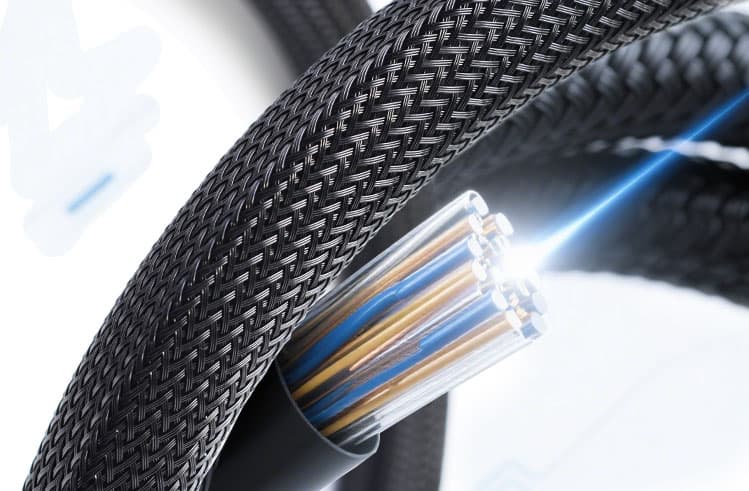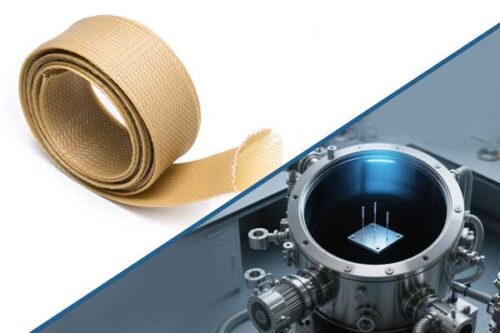While much of the discussion around fiber cable protection and fiber optic reliability focuses on bend radius and mechanical strain, real-world deployments face far more complex environmental challenges. From rack-level vibration to thermal cycling and maintenance-related disturbances, modern fiber infrastructures are constantly under stress. This is where PET braided sleeving steps in—not just as a flexible cable organizer, but as an essential environmental shield that enhances overall fiber cable protection in demanding conditions.

1.Vibration & Micro-Motion: The Silent Killers of Fiber Integrity—and Why Fiber Cable Protection Matters
In dynamic environments such as data centers or telecom base stations, low-frequency vibrations (30–200 Hz) caused by HVAC systems, fans, or adjacent rack activity can gradually wear down exposed fiber cables.
Problem: Micro-vibrations create repeated stress points, leading to microbending or connector loosening.
Solution: PET braided sleeves absorb and distribute vibration energy thanks to their woven mesh structure, reducing strain concentration on the fiber core and connectors.
2.Thermal Shifts & Cable Expansion
Thermal cycling—whether from equipment heating or ambient changes—causes fiber jackets and conduit systems to expand and contract. Without flexible fiber cable protection, rigid tubing may resist this movement, trapping stress at anchor points or within tight bends and increasing the risk of microbending or long-term damage.
PET braided sleeves, however, adapt naturally to dimensional changes:
- Their expandable design accommodates thermal expansion.
- They do not trap heat due to their breathable mesh construction.
- Optional heat-resistant coatings (e.g., flame-retardant PET with ceramic coating) further enhance fire and heat protection.
3.Cable Handling During Maintenance
Routine server upgrades, patch panel changes, and rack movements often introduce unexpected strain on fiber routes—especially in high-density MTP/MPO environments.
Traditional breakout sleeves are often rigid and require tooling for adjustment or retrofit.
PET braided sleeving with split-side or hook-and-loop design allows:
- Tool-free re-entry
- Quick visual inspections
- Easy realignment during maintenance, minimizing downtime
4.Chemical Exposure & Cleaning Agents
Server rooms and telecom stations frequently undergo cleaning with alcohols or light solvents. While plastic conduits may degrade over time, effective fiber cable protection requires materials that can withstand such exposure. PET braided sleeving, when lined or treated with fluoropolymers, offers high resistance to:
- Isopropyl alcohol
- Light degreasers
- Anti-static sprays
This chemical resistance ensures long-term durability even under routine cleaning schedules.
5.Certification Matters for Environmental Stress
For installations in mission-critical environments, meeting international standards is not optional—it’s essential.
| Stress Factor | Relevant Certification | PET Sleeve Compatibility |
| Mechanical Vibration | IEC 60794-1-2, Torsion & Crush | Available with aramid-reinforced weaves |
| Flame Resistance | UL 94 V0, IEC 60332-3C | Available in fire-retardant PET compositions |
| Chemical Resistance | RoHS / REACH | Halogen-free and low-toxicity options |
| UV Exposure | IEC 60068-2-5 | Black PET provides UV shielding |
Fiber optic systems don’t operate in lab conditions—they run in real-world environments filled with vibration, heat, movement, and chemical exposure. Effective fiber cable protection is essential in these scenarios. PET braided sleeves offer more than just neatness—they provide adaptive, certifiable, and cost-effective fiber cable protection against environmental stressors that can degrade optical performance over time.
As demands on bandwidth and uptime increase, so should the robustness of your cable protection strategy. And that starts with choosing the right sleeving for the real world—not just the spec sheet.


